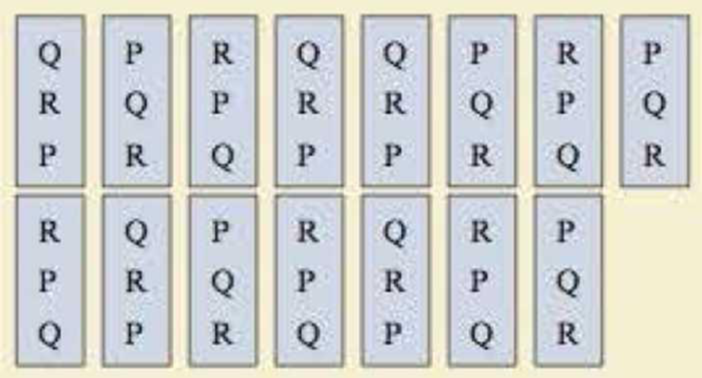
Use this information for Exercises 1–4: the preference ballots for an election for the best speaker in a contest are shown. There are three candidates: Peterson (P), Quintana (Q), and Ross (R).

1. Construct a preference table for the results of the election.
To construct: The preference table for the results in the election.
Answer to Problem 1RE
The preference table for the results in the election are listed below.
| Number of votes | 5 | 5 | 5 |
| First choice | Q | P | R |
| Second choice | R | Q | P |
| Third choice | P | R | Q |
Explanation of Solution
Given:
The three candidates are Peterson (P), Quintana (Q) and Ross (R).
The preference table of the best speaker in a contest for the election are listed below.
| Q | P | R | Q | Q | P | R | P | R | Q | P | R | Q | R | P |
| R | Q | P | R | R | Q | P | Q | P | R | Q | P | R | P | Q |
| P | R | Q | P | P | R | Q | R | Q | P | R | Q | P | Q | R |
Calculation:
The choices are Peterson (P), Quintana (Q) and Ross (R).
From the ballot preference table, it is noticed that the candidate order QRP occurs 5 times, the candidate order PQR occurs 5 times and the candidate order RPQ occurs 5 times.
That is, the orders of QRP, PQR and RPQ is 5, 5 and 5.
Therefore, the preference table of the results in the election are listed below.
| Number of votes | 5 | 5 | 5 |
| First choice | Q | P | R |
| Second choice | R | Q | P |
| Third choice | P | R | Q |
Want to see more full solutions like this?
Chapter 12 Solutions
SOBECKI ALEKS ACCESS 360 OLA MATH OUR WR
- This box plot represents the score out of 90 received by students on a driver's education exam. 75% of the students passed the exam. What is the minimum score needed to pass the exam? Submitting x and Whickers Graph Low 62, C 62 66 70 74 78 82 86 90 Driver's education exam score (out of 90)arrow_forwardExample: If ƒ (x + 2π) = ƒ (x), find the Fourier expansion f(x) = eax in the interval [−π,π]arrow_forwardPlease can you give detailed steps on how the solutions change from complex form to real form. Thanks.arrow_forward
- Examples: Solve the following differential equation using Laplace transform (e) ty"-ty+y=0 with y(0) = 0, and y'(0) = 1arrow_forwardExamples: Solve the following differential equation using Laplace transform (a) y" +2y+y=t with y(0) = 0, and y'(0) = 1arrow_forwardTemperature for Sudbury (degrees Celsius) 3. The following table gives the mean monthly temperatures for Sudbury, Ontario and Windsor, Ontario. Each month is represented by the day of the year in the middle of the month. Month Day of Year Temperature for Windsor (degrees Celsius) January 15 -13.7 -4.7 February 45 -11.9 -3.8 March 75 -5.9 2.3 April 106 3.0 8.7 May 136 10.6 14.6 June 167 15.8 20.2 July 197 18.9 22.6 August 228 17.4 22.0 September 259 12.2 17.9 October 289 6.2 11.5 November 320 -1.2 4.8 December 350 -10.1 -1.2 a) Create a scatter plot of temperature vs. day of the year for each city. b) Draw the curve of best fit for each graph. c) Use your graphs to estimate when the temperature increases fastest, for each set of temperature data. Explain how you determined these values. d) Use your graphs to estimate the rate at which the temperature is increasing at the two times from question 3. e) Determine an equation of a sinusoidal function to model the data for each cityarrow_forward
 Glencoe Algebra 1, Student Edition, 9780079039897...AlgebraISBN:9780079039897Author:CarterPublisher:McGraw Hill
Glencoe Algebra 1, Student Edition, 9780079039897...AlgebraISBN:9780079039897Author:CarterPublisher:McGraw Hill
